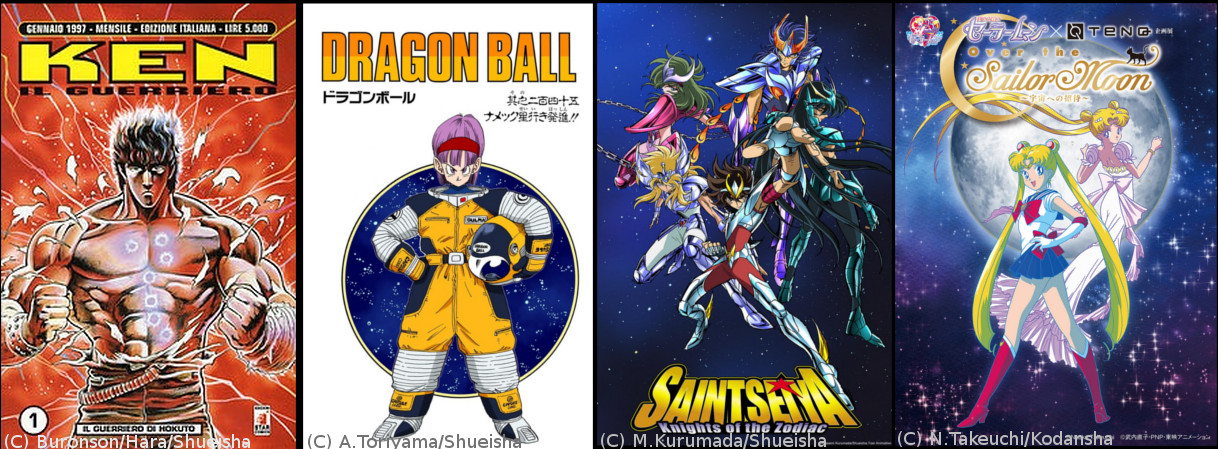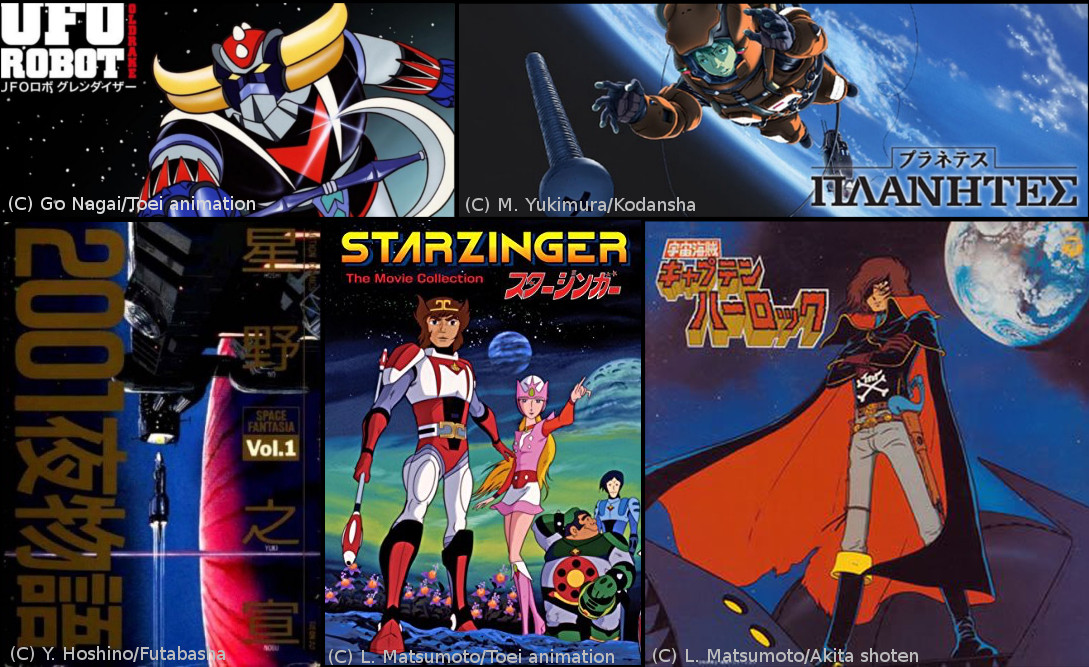Costellazione Manga: an astronomy outreach project
Can we learn something new about today's astronomy and science
by reading manga and watching anime?
Yes, we can with Costellazione Manga!!
Contents: About - Hands on - Science and artist's impressions
About Costellazione Manga
Comics and animation have a long history as tools for teaching and outreach. Since the 1940s, Walt Disney realised a number of short animated films on different themes, such as psychology, medicine, health, economy. Sweden also has a tradition of producing animated documentaries. In Italy, Bruno Bozzetto's animations made for science outreach TV programme Quark are well-known and have won prizes. Japan of course is no exception, with planetarium shows and astronomy books inspired by famous anime such as Leiji Matsumoto's Galaxy Express 999 and Starblazers (original title: Space Battleship Yamato).
The basic idea in Costellazione Manga is that anime and manga represent a common language for at least two generations in Europe, who from the 1970s onwards grew up with anime on the TV and manga in bookstores. The same has happened in several other places in the world, including the Middle East and the USA. Japanese comics and animation offer a common imagery from which Daria and her collaborators start to introduce and discuss topics in astronomy and physics. Costellazione Manga is flexible: it can be a planetarium show, a seminar, an open-air activity or an observations of the night sky. The sheer amount of available material allows Costellazione Manga to be tuned to the public knowledge, interests and expectations. Costellazione Manga is a powerful pedagogical instrument that is effective towards both the youngest and towards a grown-up public. It is even able to build bridges between generations, with parents and children learning to appreciate each other's best stories while they all learn about astronomy and physics.
The Costellazione Manga project was created by Daria Dall'Olio, now at Chalmers University of Technology in Göteborg, and by Piero Ranalli, researcher in astronomy and now an associate at Lund University, with the initial collaboration by Alessandro Montosi, an expert in the history of animation and comics, and by Marco Del Bene, professor of History of East and South-East Asia at the La Sapienza university in Rome. The project was started in Italy in 2011, when Daria joined the activities of the Planetarium of Ravenna, her home town, and of the Italian-Japanese cultural association ASCIG. Now, Costellazione Manga has followed Daria in Sweden, where the project has found an enthusiastic welcome.
Daria presented her work in the land the anime and manga come from, Japan. She described Costellazione Manga at Communicating Astronomy with the Public, the largest conference on astronomy outreach. Her plenary talk was attended by more than 450 people, and was recognised by the International Astronomical Union as one of the three highlights of the conference.
Hands on
How does a Costellazione Manga event work in practice? For a typical event, we choose three or four anime that are well-known by the local public. We recall the cartoons by showing images and playing their opening tunes. We briefly recap the plot lines, and we identify some connections with astronomy from where we start to discuss contemporary knowledge. For example, in both Galaxy Express 999 and Starblazers (Stjärnbrigaden in Sweden) the main characters visit many planets, some in our Solar System, and some outside of it. We take the cue from it to review what astronomers know about planets, and to show the latest discoveries in the field of extra-solar planets. Nowadays, more than 3000 extra-solar planets are known: they are of different types, sizes and chemical compositions. Depending on their orbit, they can have freezing or scalding climates. Some of them lie in the so-called "habitable zone", where temperatures are mild and liquid water might be present, but we still don't know any planet whose climate is similar to that of Earth. Sometimes we have "bad news": the fans of UFO Robot Grendizer might be disappointed to learn that astronomers have found no signs of planets around the star Vega, from which their favourite giant robot supposedly comes from.
Among the animes that get regularly featured in Costellazione Manga there are also Starzinger (particularly famous in Sweden), Fist of the North star and Saint Seiya (that introduce the topic of constellations, both according to the Western tradition, and to the Chinese-Japanese one). Some works may be less famous with the public but may deal with more adult and authorial topics, such as 2001 Nights or Planetes. These works can introduce some introspection on the relationship between humanity and space: what are the risks and the benefits of the human presence in space? How fragile is it?
Science and artist's impressions
Artist's impressions have a key role to transmit new discoveries from scientists to the public in several fields of science. This happens every time that instrumentation cannot offer immediately understandable images. In astronomy, high-resolution images of most Solar system planets are nowadays available, but this is not the case with extra-solar planets, for which we rely on other clues to infer their existence. Artist impressions therefore try to express what astronomers deduce from their analyses: chemical composition, temperature, revolution period, mass and insulation level of the planets. NASA has adopted this outreach strategy by producing a series of retro-looking posters that present some extra-solar planets as if they were tourist destinations. These posters are extremely effective in conveying an idea of the conditions that are thought to exist on those worlds: icy, hot, or constantly irradiated by X-rays and gamma rays. Costellazione Manga draws from comics and cartoons produced from the 1970s to today, and therefore it allows to show how our knowledge and imagery has developed during the years. Last not least, the images that we take from comics and cartoons are immediately recognisable as such, and there is no risk of confusing them with real astronomical images – a risk that can happen when very detailed and accurate artist impressions are not explicitly labeled as such.




